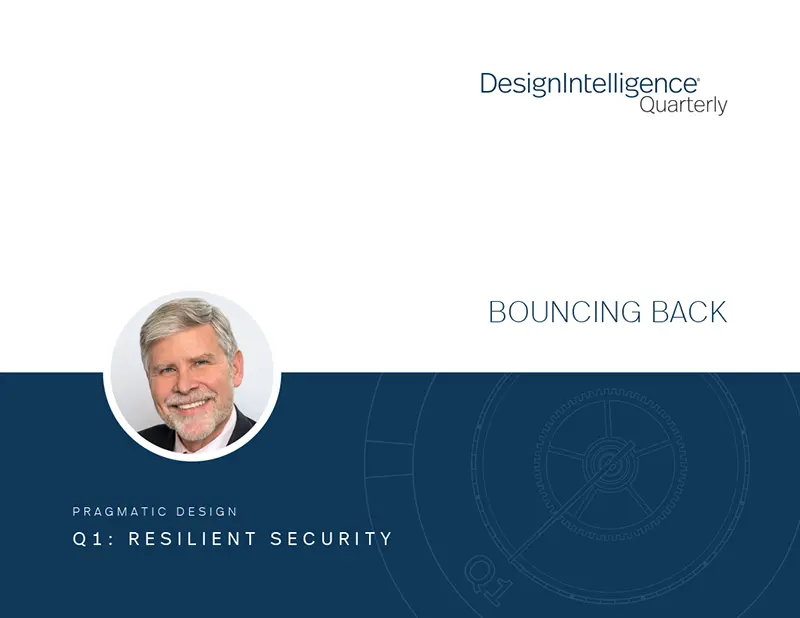Bouncing Back
by Scott Simpson, FAIA
Senior Fellow, Design Futures Council
January 4, 2023
Scott Simpson offers navigational advice for firms.
These days, there seems to be a bull market in bad news. Inflation is raging, politics are messy and war in the Ukraine threatens global energy markets. Dire predictions are easy to come by, and they are largely credible. If you happen to be a pessimist, these are boom times. Should the worst happen, how will we handle it?
Start by taking a deep breath. Not everything will unfold as expected. (Remember the adage that economists have predicted nine out of the last five recessions!) In fact, the world is not coming to an end, nor will it any time soon, despite what some soothsayers would have us believe. Doomsday scenarios can be compelling, but that does not mean they are inevitable.
The truth is that there has always been plenty of bad news to go around. That said, human beings are a nostalgic breed, inclined to reconstruct an idealized past, recalling the best parts while glossing over the worst. Bad news looks much different when viewed through a rearview mirror. If you doubt this, just hop in your time machine and travel back to 2008, when the world economic system was teetering on the brink of collapse. Not only did that not happen, but the “Great Recession” was followed in short order by the biggest economic expansion in history, lifting tens of millions of people out of poverty.
Nature and history are cyclical. While the oil embargo and gas crisis of the 1970s (remember them?) seemed to presage the end of Western civilization, that did not happen. When the dot-com bubble burst at the turn of the century, it looked like Big Tech was just an empty promise. Then came iPhones, Facebook and Amazon. Even the COVID-19 pandemic, as bad as it has been, now seems to be in recession, if not remission. This is not to suggest that all problems will disappear by themselves (they won’t), but rather that human beings, who are collectively quite capable problem-solvers, will figure out how to cope and eventually overcome.
These days, the prospect of global warming has created plenty of hand-wringing. Just consider the Thwaites ice shelf in Antarctica. It’s massive (about 70,000 square miles — larger than Florida) and is rapidly eroding from underneath due to rising seawater temperatures. The ice shelf acts as a huge dam. If it were to give way, the Thwaites glacier (nicknamed the “Doomsday Glacier” by climate scientists) would slide into the sea, raising water levels globally by about two feet. This would swamp many coastal cities and even put certain low-lying countries permanently out of business. What happens then?

It may well be that we are past the point of prevention, but we are not past the point of invention. In real life, there is no status quo. Things are constantly in flux, and somehow humans have always found ways to adapt. While some of our problems are imposed by Mother Nature, many are self-inflicted. Humans have proved themselves (at least so far) to be endlessly inventive. We may be great at creating problems, but we are even better at solving them.
The bottom line is that when bad stuff happens, creative juices start to flow. This is where design thinking comes in. Problems generally come in two sizes: large and small. The big ones may seem daunting at first, but like a pile of rocks, they can usually be broken down into their constituent parts and then handled one at a time. The key is not to be intimidated by the size of the pile. It never entirely goes away — it just gets replenished from time to time. Put another way, problem-solving is what designers do for a living, and so a steady stream of challenges is not necessarily a bad thing.
Sometimes it’s the small problems that cause the biggest heartburn. In our tendency to avoid conflict, small problems can quickly escalate to the size of boulders if left unattended. The best way to deal with problems of all sizes is to expect them. Like icebergs in the North Atlantic in winter, we know they are out there, even if we don’t know exactly where. We also know that what may look like a small iceberg at first is really massive underwater. A good captain avoids trouble by staying alert and navigating around obstacles. It’s when you think you don’t have a problem that you are actually most vulnerable (just ask Edward Smith, the captain of the Titanic).
Like good chess players, design firm leaders need to play the whole board, not just the individual pieces, and they need to think several moves in advance. Anticipate what may or may not happen. Develop multiple contingency plans. Adjust your strategy to changing conditions as the game unfolds. Be alert for surprises. And, at all times, keep the endgame in mind and then work backward from that.
While leading a design firm can be devilishly complex and full of surprises, focusing on a few key variables will pay big dividends. First and foremost, track your backlog. When winter comes, you’ll want to have a big pile of firewood on the front porch. If backlog starts to dip, then beef up your marketing efforts or adjust staffing to actual demand. That will buy you some time.
After that, monitor staff utilization. Make sure that the staff you do have are productively engaged. Too much unbillable time is a red flag. It can quickly lead to project losses that place a heavy tax on your future. Don’t let that happen.
Finally, control your overhead. Spend what’s necessary to keep the enterprise running smoothly but avoid indulging in unnecessary expenses that do not directly support the mission of the firm. It’s OK to spend a dollar as long as you make that dollar count for something.
Properly managed, those three basic metrics (backlog, utilization and overhead) should keep the firm on a steady course, able to withstand strange currents and choppy waters.
The good news is that at heart, designers are problem-solvers. When bad stuff happens, they figure things out. Ironically, the biggest problems can present the best opportunities, because they demand out-of-the-box thinking and truly innovative solutions. (It’s hard to risk a quantum leap when things are going well.) A look backward offers reassurance that we’ve overcome huge challenges in the past. A look forward provides the strategic optimism to tackle what’s coming next, whether it’s expected or not.
One thing is for sure: There are plenty of icebergs out there, and they are headed our way.
Scott Simpson, FAIA, is a senior fellow in the Design Futures Council and a regular contributor to DesignIntelligence.


